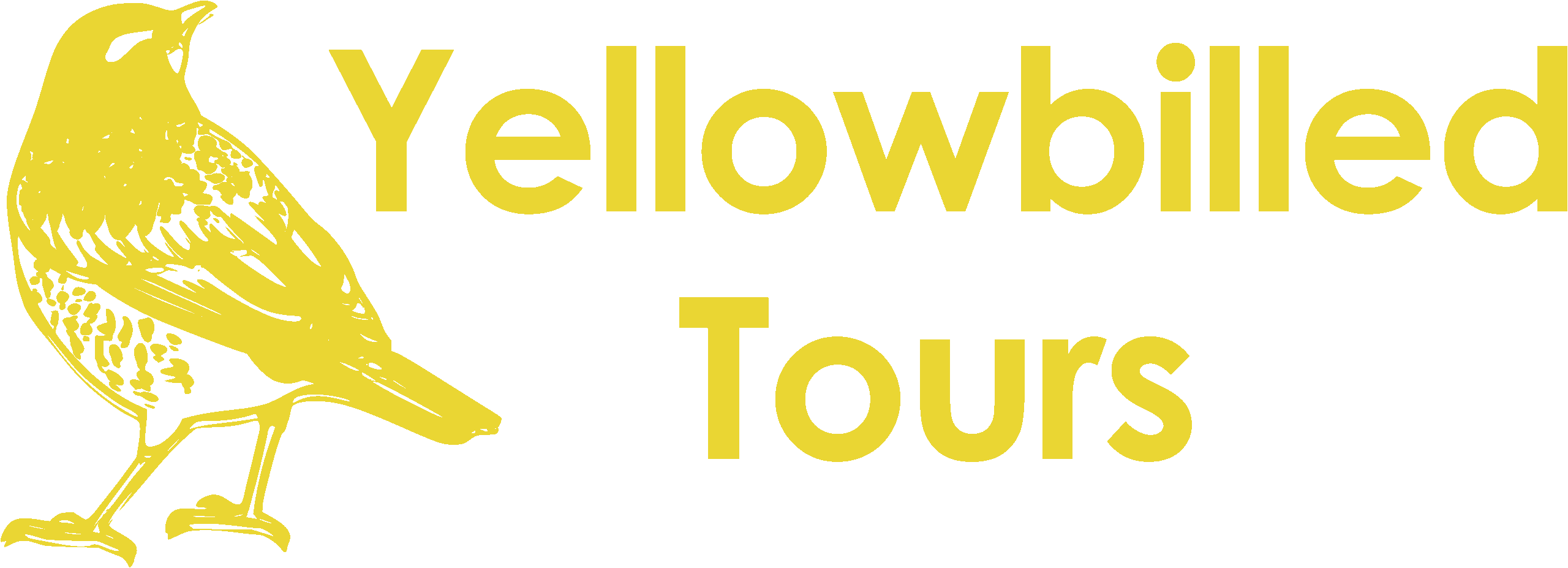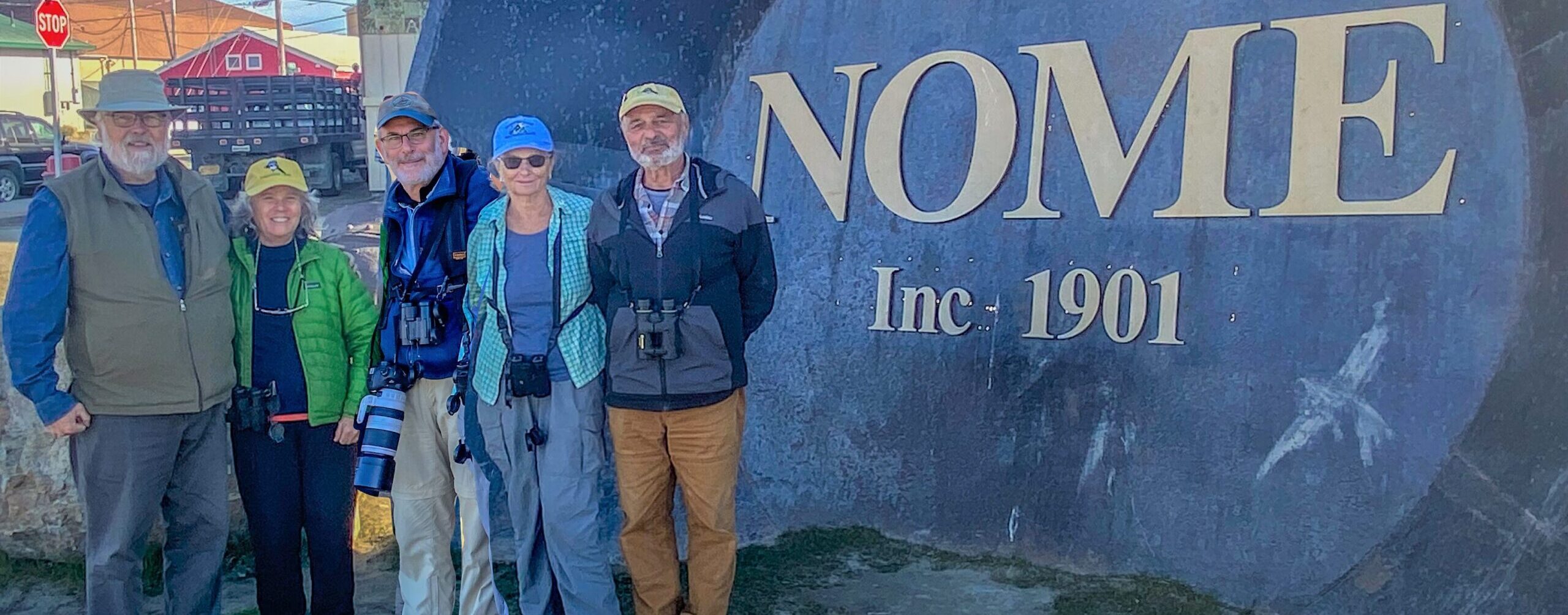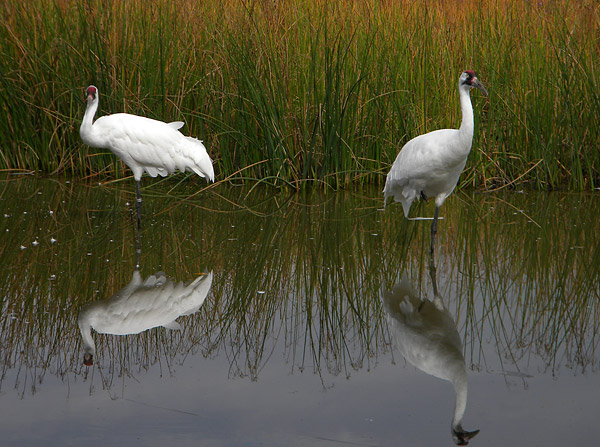[et_pb_section admin_label=”section”]
[et_pb_row admin_label=”row”]
[et_pb_column type=”4_4″][et_pb_text admin_label=”Text”]
The Godwit’s Long, Long Nonstop Journey
Researchers marvel at the bird’s record-holding migratory flight of 7,000 or so miles from Alaska to New Zealand at this time of year. No eating or refueling along the way. Click on photo for full story.
The Nome 2023 Registration is now open, call 925-353-0266

Hi Paul, Better Red-tailed Hawk photos, thanks for sending. I’ve shared this with others including the folks working on the “Red-tailed Hawk Project” and our collective opinion is the same as before—this bird is one of the intergrade types from the n. Great Plains, likely n. Alberta. Neat record, and a long way from home up there. Brian Sullivan, Cornell Lab of Ornithology, eBird leader.
The Red-tail Hawk discovery while a group effort was narrowed to down by Kathleen Krall yelling it’s a Red-Tailed Hawk! Michael Krall, an Excellent bird photographer began rapid burst mode to capture the raptor before it flew off. Kathleen and Michael are shown below in the group photo.
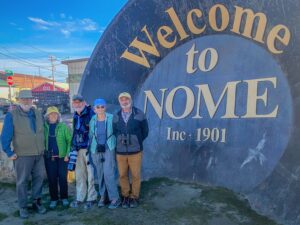
The Yellowbilled Tours uses Nome, a frontier town of nearly 4000 residents, as a base camp for your field trip. Nome is accessible only by ship and airplane, bordered on the West and South by the Bering Sea, and the North and East by miles of trackless wilderness.
Nome is a fascinating and challenging destination. During late May, June and July, the sun is at its brightest into the late evening, the tundra is in full bloom, and the birds have begun arriving to nest. Mammals are active also building up fat for the winter ahead. You may see Muskox, Moose, Reindeer herds, arctic fox, and bear.
Our tour will cover the prime birding areas along the coast plain, including the length of Safety Sound Lagoon and Wooley Lagoon with beautifully blooming inland alpine tundra, rivers, and the wetlands surrounding Nome. We will also spend time birding our way to the boreal spruce forest towards the town of Council. Most of the birds are in their striking, fresh breeding plumages—rarely if ever seen in the lower 48. We make an extra effort to locate some of the accidental Asian species—such as Bluethroat, Yellow and White Wagtail, Arctic Warbler, Northern Wheatear, Snow Bunting, Gray-tailed Tattler (seen on a 2006 YBT trip)—that regularly occur at Nome.
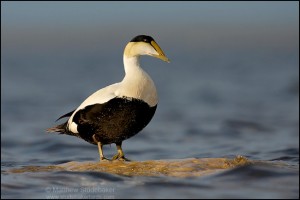
I began birding the Nome eco-region in 1998. I have been leading small-group birding trips to Nome’s eco-region since 2002. My trips include wildlife watching as well, providing a relaxed experience. We stay on the bird until everyone has a chance to observe it. At each sighting, we take time for birders to collaborate using the available field guides. Our visit will not be a high-speed tour with no time for field collaboration or in-town Nome cultural experiences.
The field trips are limited to 6 birders to maintain comfortable spacing for a small group that Yellowbilled Tours have established for Nome. The vehicle used is a Ford four-door dual cab or a 10-passenger van vehicle, allowing each birder a speedy and comfortable entrance and exit and plenty of window viewing area. This vehicle allows comfort and convenience on rough, unpaved roads.
The small group will provide a comfortable and personalized birding experience. Our lodging is a modern lodge with clean rooms and private baths. The weather will be mild for Nome—ranging from 30 to 55 degrees—but will require layers of clothing for maximum comfort.
Birding Nome, in the tundra habitat.
What Is Tundra?
Tundra covers an estimated 10 percent of Earth’s surface, primarily in the Northern Hemisphere, in polar and alpine (mountainous, high elevation) areas. In both situations, cold temperatures, strong winds, snow cover, and short growing seasons result in open landscapes that give the biome its name, which is derived from the Sami word tūndar, meaning “treeless hill.”. The following is from the Spring 2022 “Changing Tundra and What It Means for Birds” from the (American Bird Conservancy https://abcbirds.org/blog/changing-tundra-impact-on-birds). Permafrost, perennially frozen soil, is a ubiquitous feature in these areas, and in place of trees, tundra regions are rich in dwarf shrubs, grasses, herbaceous plants, mosses, ferns, and lichen. Within North America, the Arctic tundra covers northern Alaska, Yukon, the Arctic islands of Canada, portions of the mainland of the Northwest Territories, Nunavut, and northern Quebec. The terrain across this broad mantle of land is highly variable, ranging from vast plains, rolling lowlands, and ice-covered lakes to flat-topped mountains and snow-free uplands. Expansive wetlands are common, particularly in shield or bedrock regions of eastern and central Canada. The North American tundra is the homeland of many Indigenous peoples, including the Aleut, Yupik, and Inupiat in Alaska, and the Inuit (Inuvialuit) in Canada, who depend on healthy populations of fish, mammals, and birds for subsistence harvesting. Bird populations are particularly abundant there, especially during productive summer periods, when more than 135 species breed across North American tundra. (Across the world’s Arctic region, the figure may reach 200 species.) Geese and shorebirds often dominate tundra bird communities, but other representative species include Yellow-billed and Red-throated Loons, Long-tailed Duck, King Eider, Peregrine Falcon, Parasitic Jaeger, Willow and Rock Ptarmigans, Hoary Redpoll, Lapland Longspur, and Snow Bunting.
Road to Kigluaik Mountains, outside Nome, Alaska
Each morning after breakfast, we’ll pick up our own individual lunches. Dinners will be a hot meal of your choice in Nome. The cost of meals is not included in our price.

An evening of Arrival: I will pick you up at the Nome Airport. You’ll have your pre-registered in your room. Then we go to dinner as a group. During dinner, I’ll review the required trip safety protocols. After dinner, we’ll begin birding along the Bering Sea, Nome Harbor, Nome and Sewage Ponds. We can expect to see American Tree Sparrow, Chestnut-collared Longspur, Red-necked Loon and Red-necked Phalarope, up to three species of Gulls, possibly three species of Jaeger, Aleutian Terns, possible Bar-tailed Godwit and both Pacific and American Plover—all in breeding plumage.
Day 1 Safety Lagoon and Council Road: We’ll spend the morning hours carefully searching the shorelines, lagoons, and ponds near the inlet from the Bering Sea for rarities such as Arctic Loon, Black-legged Kittiwake, Slaty-backed Gull, possible Common, Steller’s and Spectacled Eider, as well as the many resident shorebirds and terns. In 2014, we had King Eider on the beach. Then we will drive on dirt roads toward Council, a small fishing village in the interior, searching along the way for Northern Shrike, Rough-legged Hawk, Redpolls, Yellow Wagtail, and Gray-cheeked Thrush. In past years, we have also had White Wagtail and White-winged Crossbill on this road. This area represents the northern boreal forest limit on the Seward Peninsula and should also yield Varied Thrush, Boreal Chickadee, Rusty Blackbird and other spruce forest/alpine species. In 2011, we found a male singing Harris’s Sparrow in Council. In 2012, we discovered Bohemian Waxwings—very rare birds for the region. In 2014, we had Slate colored Junco- another bird rare considerably north of its breeding range.
Day 2 Wooley Lagoon: We begin with local birding, and in just a few miles, we may be able to find Arctic Warbler, Northern Wheatear and Pacific Loon. Then our real day begins by slowly driving north on Teller Road, seeking both species of Ptarmigan, Western and Semipalmated Sandpiper, Red-necked Stint, Golden Eagle, Northern Waterthrush, Arctic Warbler, and possible American Dipper, Rusty Blackbird or Rock Sandpiper. We’ll bird the road into the Wooley Lagoon searching for Black-bellied Plover, Pacific Golden-Plover, and American Golden-Plover as well as Semipalmated Plover, Whimbrel and Northern Wheatear. We should also get good looks at Parasitic Jaeger, Yellow Wagtail, and Snow Bunting in this area. In late June 2012, a White Wagtail was found in this area.
Day 3 Taylor and Kougarok Roads: We drive along the 72-mile Kougarok Road into the high tundra and mountains of Seward Peninsula in search of nesting Whimbrel, Wandering Tattler, several nesting-plumage sandpiper species, Black and Ruddy Turnstone, Semipalmated Plover, Red Fox Sparrow, and Northern Shrike. At road’s end is Coffee Dome, a large, sloped mountain. This is where the Bristle-thighed Curlew nest and is our best chance to see it. This area also has potential for Bluethroat, Gyrfalcon, Blackpoll Warbler, and Northern Waterthrush. We’ll watch (carefully) for Grizzly Bears, Muskox, and Moose.
Day 4, we will be focused on birding the Bering Sea and chasing missed species along the Safety Sound lagoon coastal habitats.
The total cost of the four-day Nome field trip is for a couple is $3600.00 each, and a single is $3900.00. The trip cost does not include airfare or meals. A $1,600.00 deposit is required upon registration. The balance is due March 23, 2024, for all trips. If you cancel up to 60 days prior to the trip start date, a $800.00 administration fee will be charged. If you cancel after the balance is paid, there can be no refund unless a replacement is found. YBT is not responsible for finding a replacement.
Nome Field Trip Group 1: Arriving in Nome on the evening of May 28, 2024, with you arriving on the evening flight from Anchorage. I will pick you up at the Nome Airport. I’ll have you register for your room. We’ll have a meet-and-greet dinner, after which the birding will begin. You will depart on the evening flight to Anchorage on June 1, 2024.
Nome Field Trip Group 2: This field trip starts on the evening of June 1, 2024, with you arriving on the evening flight from Anchorage. I will pick you up at the Nome Airport. You can go directly to your room and then join a meet-and-greet dinner, after which the birding begins. You will leave Nome as a group on the afternoon flight to Anchorage on June 5, 2024.
Clients reflections of the Nome Field trip June 2021. BY Dede of Somona Cal. June 5,2021 Thanks so much for a memorable trip. You did an excellent job. I look forward to future adventures with Yellowbilled Tours.
BY Jim of Novato, Cal. Thanks, a terrific field trip ! I baged 23 life birds!
Client testimonial’s:
June 13, 2018
Donna of El Granda, California wrote:
“Why go all the way to Barrow? EIDERS!
It’s the best place in the world to see all four species of Eider.
A very late winter thaw made it more difficult than usual to find them.
But our persistent and diligent guide, Richard Cimino, Yellowbilled Tours found them all for us.”
June 1, 2018 field trip – wanted you to know that the Nome trip was the best of my all-time birding moments. We really appreciate your hard effort to get us on good birds each day and your tremendous knowledge of the area. Both of us had a wonderful time and I am happy to tell everyone what a great guide you were and what a singular experience the Nome trip can be. I feel I came away with a better understanding of the birds and their environment- certainly, jaegers have moved up in my list of favorites! And of course, the Marlo every evening was good as well. (-:
– Anyway, thanks so much, and I hope to bird with you again in the future.
Best regards,
Jon
Jon W Wise | Partner
1100 Poydras Street, Suite 2300
New Orleans, LA 70163
o: 504-585-7549 | f: 504-544-6137
chaffe.com | linkedin | bio | vcard | email
June 2017 field trip – Although I’ve been a birder for over 40 years, my Nome visit with Yellow-billed Tours was the first I had signed up for a birding tour. It was excellent! I probably would not have found much more than half the species we saw if I had undertaken this visit alone. My favorite experience was seeing an Ivory Gull at close range — never an easy find here in June. With just 5 persons in our group, the birding and photography goals of each of us were well attended to. Our leader was professional and patient in balancing everyone’s needs. His many years of birding around Nome clearly helped us find nearly all the species we sought, as well as illuminating the ecology and culture of the region. Whether you’ve never taken a birding tour before or have taken many, I highly recommend Rich Cimino and Yellow-billed Tours.
Paul Adamus, Oregon
June 2017 Barrow Alaska: Thanks for leading such a great discovery of the birds of Barrow. We left very few stones unturned and I know you gave it all you had, thanks again.
Dave Sexton, Novato, Ca.
June 2016
I went with Rich and Yellow-billed tours last June to Nome and Gambell for a total of days 8 days. My 2 friends and I had a good time and saw most of our target species including the Bristle-thighed Curlew and Bluethroat. I would certainly recommend him as guide and organizer. One item we liked most was the small group venue and the use of his four door Ford pick-up truck. If you have time, Anchorage is worth a few days, and a boat trip off the Kenai Peninsula is also excellent.
Michael, Oakland, Ca.
Nome 2016
Rich,
I want to thank you for the wonderful tour and fun time in Nome. It was the best! I look forward to another tour with you in the future. Adam and Martin were perfect traveling companions, a group of five that’s hard to beat. The birds and wildlife were pretty good too. And the Polar Cafe, my favorite!
Nancy Panther, Lone Pine California
Thanks.The Nome was planned well. Your passion and depth of knowledge mirrors your character and humor. Know that what you do and how you do it are appreciated! MP
Martin Powell, Lone Pine, California, 2016
Nome 2015
Hi Rich,
Thank you for leading this great birding trip to Nome. I had a lot of fun and got 16 life birds! Thanks for the personal touch and all the extra like the hat and the extra morningof departure for the extra birding time.You did a great job! Hope to see you soon on another field trip.
Stephanie Floyd,
Nome 2015
Rich thanks for the great birding trip into Nome. The landscape and birds were wonderful. All the life birds especially the Bristle-thighed Curlew is the one to remember.
Elaine Voknoun
Milwaukee, Wisconsin
Fremont, California
Nome 2014
Never in my wildest dreams would I have ever thought of going to Nome, Alaska, but after hearing Rich Cimino’s presentation at the Napa-Solano Chapter of the Audubon Society meeting, I was hooked. Soon after the meeting, I sent in my deposit for the May 2014 trip.
It was the trip of a lifetime. Rich took us on the three main roads out of Nome and each day we birded until we couldn’t bird any more. We also spend quite a bit of time birding in and around Nome. The scenery was fantastic and the trip was worry-free as Rich handled all of the logistics, including changing a flat tire at the Pilgrim River. Rich made sure that once a bird was sighted, that he kept the scope on it until everyone had a chance to see the bird. I came away with 45 new species of birds that I’d never seen before and learned that if you want to see new species, you need to go to new places! I highly recommend Rich’s tours to anyone who wants to see new bird species and wants to have a carefree birding trip where all the details are expertly handled. Thanks, Rich, for everything you did to make this trip fantastic.
Jane H., Vallejo, CA
Rich,
Great birding trip. Great rooms and loved the meals. Loved the small group size. Francoise – 2014
Hi Rich, This is an email from a very satisfied customer. A few years ago (2013), you led myself, wife Rosemarie, and grandson Nick on your wonderful Nome tour. saw all the target birds and Nick remembers it as his best vacation ever. I ceased attending bird tours after I saw North American Bird #700 several years ago.
Best wishes, Lud Deppisch, Tucson AZ
** Gambell St. Lawrence Island Extension – By special request begins with the morning flight from Nome to Gambell. We have rooms at the Lodge in Gambell. The birding in Gambell is by foot or ORV – cost not covered in fee. The areas which are rich with Asian migrants are close walking distance from the lodge. We will frequent the Boneyard area which is a grave yard for harvested whales by the Yupik Villagers. This area is one of the first location where birds find land. This area has produced many great Asian migrants over the years. We’ll bird the huge breeding colonies of Alcids on the cliffs of the Chibukak Point. We can plan to spend as much time in these areas as you wish. Contact Rich Cimino for trip cost and air flight scheduling, clothing requirements and menu items.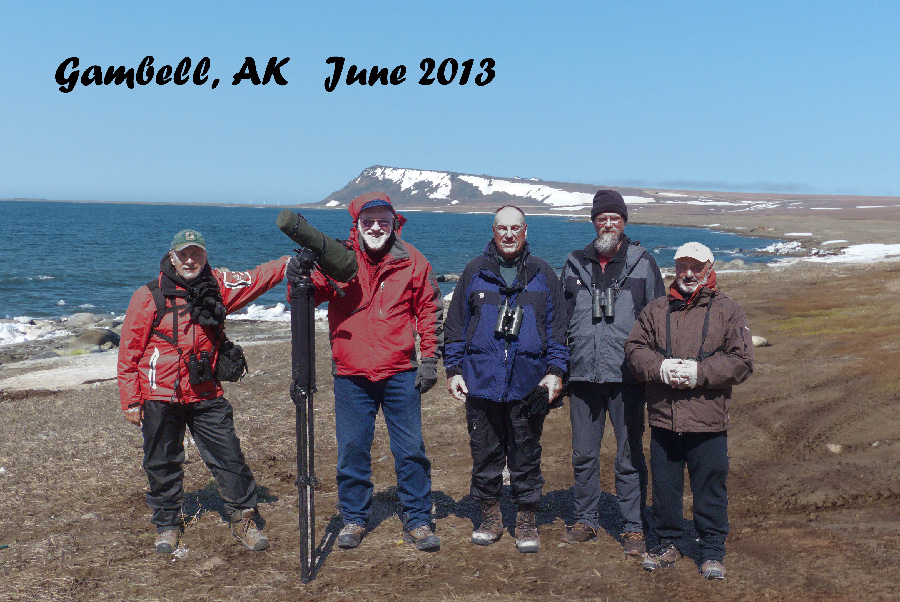
*Other mammals we may see here and in other locations on our trip include Short-tailed Weasel, Spotted Seal, Harbor Porpoise, Walrus (immature), and others. Note:The sequence of the daily trips is subject to change due to weather or road conditions or rare bird sightings.
Contact Rich Cimino at 925-353-0266, or Yellowbilledtours@gmail.com to reserve a space on the June 20, 2020 field trip. Space is limited to four birders per field trip to assure you a comfortable field trip. Rich Cimino is your guide; he supplies the lodging, and field guide services. ORV transportation, fuel, Airfare and meals are not included.
Travel Safety & Comfort Advisories: Planning your clothing is important to reduce your luggage needs. During the YBT field trip you do not get dirty, one change of clothes is enough for the entire field trip. You will be responsible for carrying and loading your luggage. You can to bring your own scope. You are limited to small back pack to carry daily with your snack and misc. personal items. No large backpacks are needed on these day trips. Do not wear fragrances (lotions, aftershave, or colognes), which may attract bears. For client safety this trip cannot support handicapped persons or persons with significant hearing disabilities. If you have limited hearing or if you use two hearing aids, we need to discuss your limitations during the registration period. YBT uses four wheel drive, four-door Ford Pick-up trucks. These trucks have a high step up feature with no running boards. If you have a short step reach this may be uncomfortable. We need to discuss what YBT can do to offer assistance.
The photo above is from 2015 Bristle-thighed Curlew chase which was successful.
[/et_pb_text][/et_pb_column]
[/et_pb_row]
[/et_pb_section]
